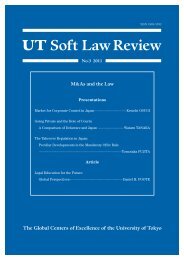UT Soft Law Review
UT Soft Law Review
UT Soft Law Review
You also want an ePaper? Increase the reach of your titles
YUMPU automatically turns print PDFs into web optimized ePapers that Google loves.
<strong>UT</strong> <strong>Soft</strong> <strong>Law</strong> <strong>Review</strong> No.2 2010(6) (Page 9 and page 12) An example of a scheme in which shareholders are able to terminatethe defensive measures at one general shareholders meeting by replacing directors is ascheme in which the defensive measure is terminable by the board of directors and the termof office for directors is set at one year.(7) (Page 9) This is the so-called sunset provision.(8) (Page 9) For example, the board may, upon its resolution, issue and allot to all shareholdersstock acquisition rights, etc. with discriminatory exercise conditions, for example, rightswhich are not exercisable by shareholders who own more than a certain percentage of thestock or may make a board resolution to issue such stock acquisition rights, etc. as an allocationto shareholders.(9) (Page 10 and page 12) A defensive measure would be considered unfair, if, for example, it (i)becomes non-terminable in the event that any of the directors in office at the time of adoptionis replaced, (ii) is non-terminable if a majority of the directors in office at the time of adoptionare replaced, or (iii) is non-terminable for a certain period of time after a majority of thedirectors are replaced. In contrast, for example, if stock acquisition rights, etc. have aredemption provision under which the term of the rights will be periodically extended withapproval at shareholders’ meetings or consent of a certain percentage of shareholders but willbe redeemed if such approval or consent is not obtained, such rights will be viewed as morefair, since it shows that such defensive measure reflects shareholders’ will.(10) (Page 11) If there are shareholders who already own more than the specified percentage ofstock, such as 20%, at the time that takeover defense measures are introduced, excludingsuch ownership from causing the defensive measure to be triggered does not constitute “differentialtreatment among shareholders other than the acquiring person”.(11) (Page 13) For example, this is a mechanism through which the board of directors will terminatedefensive measures and move toward the TOB if the acquiring person presents definitiveinformation on the acquisition offer, the time necessary for the board of directors to negotiatewith the acquiring person and pursue alternatives is ensured, and shareholders are providedwith adequate information. It is reasonable to specify the conditions according to the situation.For example, in the case of a cash offer for all shares, since this is not inherently coercive,it is reasonable to limit the negotiation period to between one and several months, afterwhich the takeover defense measures are removed and a transition is made to the TOB. Inthe case of a proposed partial acquisition, or where securities, etc. are proposed to be usedfor the consideration, a longer negotiation period is reasonable. These kinds of objective terminationcriteria are superior in ensuring the path of TOB in all acquisitions, in principle.Unlike other takeover defense measures, these are sufficiently reasonable, even if it is onlythe inside directors who make the decisions about the takeover defense measures.(12) (Page 13) In the case where termination provisions provide that the takeover defenses willnot be terminated in the event of a partial offer, but will be terminated and a TOB will be commencedonly in the event of all cash for all shares offer, an outsider’s participation is presumablynecessary, such as an analysis by outside experts (lawyers and financial advisors forexample) on the appropriateness of the acquisition price and other terms, and consent of out-89





